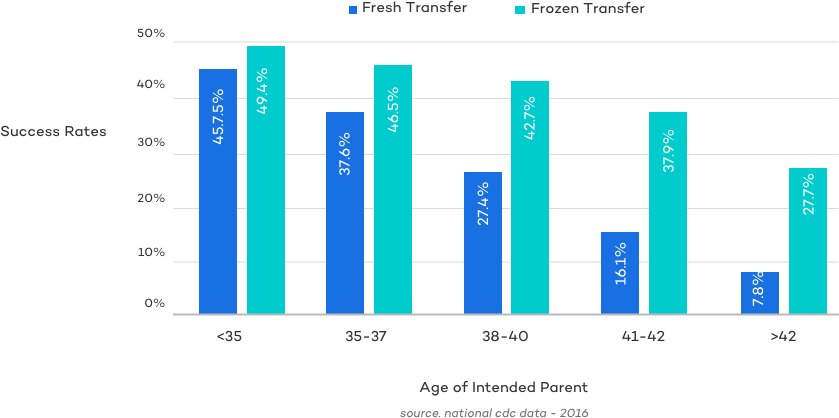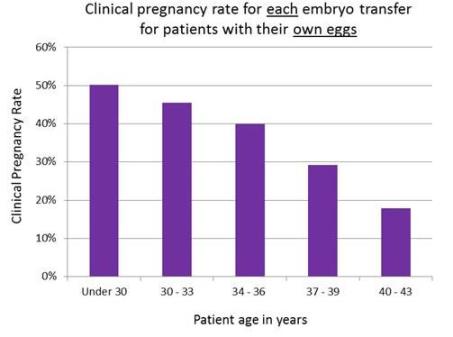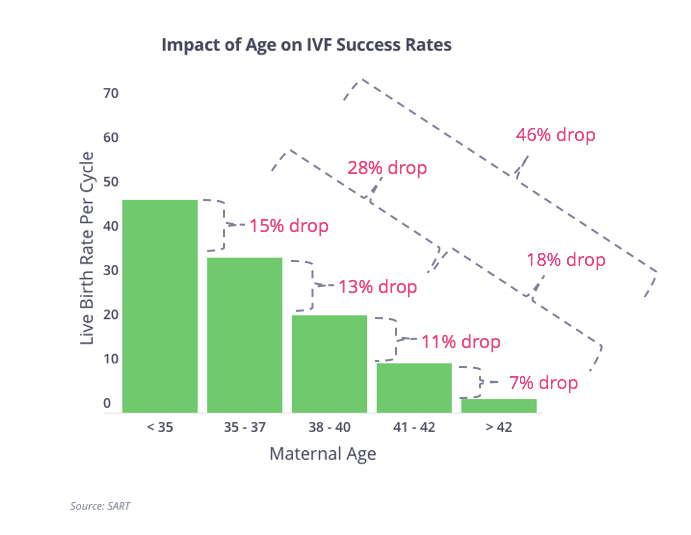What Is The Success Rate Of Ivf On The First Try
rate whatWhile the devastation that often accompanies a negative pregnancy test after IVF is completely natural it is important to understand why it is that IVF pregnancy rates are not 100 and why in most cases you should consider trying again. IVF Success Rates by City.
 5 Must Dos For Embryo Transfer Success Things To Do After An Embryo Transfer To Get Pregnant Ivfaffir Getting Pregnant Tips Embryo Transfer Getting Pregnant
5 Must Dos For Embryo Transfer Success Things To Do After An Embryo Transfer To Get Pregnant Ivfaffir Getting Pregnant Tips Embryo Transfer Getting Pregnant
But reported success rates vary quite a bit from study to study.

What is the success rate of ivf on the first try. A tubal reversal results in a 70 to 75 success rate for a 35-year-old woman while IVF results in 40 to 50 success. For instance a woman who is under age 35 and undergoes IVF has a 396 chance of having a baby while a woman over age 40 has an 115 chance. Fast Facts about IUI Success Rates Across all patients types IUI cycles have live birth rates per cycle of between 5 15.
Overall IVF success rates are only slightly lower for second attempts as compared to first IVF tries. The most up to date IVF pregnancy success rates for IVFAustralia are available here. The only way you can find out if IVF will be successful for you is to try a few cycles.
The chances of pregnancy will depend on the age of a womans eggs and many other factors particular to a couple but on average only 37 percent of assisted reproduction cycles for women under 35 result in live births. Whereas for patients who are over 40 years old the success rate is less than 20. The success rate of an IVF cycle on the first try is largely dependent on the age of the female patient.
Using the information that you enter below this tool allows you to estimate your chance of having a live birth using in vitro fertilization IVFthe most common type. However the CDC recently found that the success. A little less than half of the transferred embryos result in successful implantation.
The success rate for tubal reversal is higher than with IVF but not an option for all women since the procedure requires a minimum amount of healthy fallopian tube left to do so. IVF success rates vary upon age. Depending on the age of embryo the embryo freezing method can make a noticeable difference in success rate of IVF first time.
Using vitrification the live birth rate jumps to 299. Checking on the embryos. Some individuals are extremely lucky and get pregnant on their first cycle of IVF the reality is that most dont.
The graphs take into account womans age but they do not factor in an individuals unique health fertility complexities or circumstances. The chances of success decrease with age. While there is an overall 50 percent success rate the procedure may not work for you.
You can only use your own eggs until the age of 45. For example 30-34 year old women at the time of egg retrieval with a healthy fertility diagnosis and 5-day embryos have a 254 live birth rate using slow freezing. A woman 35 and younger will have a 30 - 50 success rate per cycle and 80 or better after three cycles.
Despite continuing improvements in the technology unfortunately there are times when IVF is not successful on the first or second try. For all women the odds of having a baby on the first IVF attempt was 295 percent. Couples with the best egg quality are more likely to get pregnant on their first try but this is balanced out to some extent by potentially learning from the first failed cycle and making adjustments to maximize success for the second in.
For patients that are under 40 years old the chances of getting pregnant are around 34 to 62. The other three quarters of the group went home empty handed. Although there are many factors by some estimates about 50 percent of mature eggs become fertilized using standard insemination and 60 to 70 percent are fertilized via ICSI.
What these results show us is that while 23 of cycles initiated and 31 of IVF cycles undertaken resulted in a pregnancy only 25 of women in this sample group actually ended up with a baby after a year of IVF treatment. The data shown in the graphs is dated as far back as 2017 so does not reflect current IVF pregnancy rates. Others put the success rate at 80 percent of mature eggs being fertilized overall through in vitro fertilization.
That stayed pretty steady through their fourth attempt but the chance of having a baby jumped up to 65 percent. At the age of 42 the chances of you getting pregnant are at 10 and by 43 years it drops to 5. Each individuals situation is different.
CDC gathers data from every fertility clinic in the United States each year as part of the National Assisted Reproductive Technology Surveillance SystemThis allows CDC to monitor success rates of some infertility treatments. A combination of donor eggs and IVF gives women above 40 years of age a 20 chance of getting pregnant per cycle. Some studies show just an 8 success rate using fertility drugs and IUI while other studies find success rates over 20.
When donated eggs are used success rates per cycle rise to 60. Conversely women over age 42 have 5 success rates per cycle and less than 10 after 3 cycles. These IVF success rates for age under 35 are highest compared to older age groups especially for implantation rate which drops to under 8 in women over 42.
 Success Rates And Your Stories Cambridge Ivf
Success Rates And Your Stories Cambridge Ivf
 Embryo Transfer What It Is What To Expect Different Types Costs And More
Embryo Transfer What It Is What To Expect Different Types Costs And More
 Ivf Success Rates By Age And Number Of Embryos
Ivf Success Rates By Age And Number Of Embryos
 Pin On Top Health Topics Female Reproductive System
Pin On Top Health Topics Female Reproductive System
 Ivf Success Rates By Number Of Eggs And Age Egg Quality And Quantity
Ivf Success Rates By Number Of Eggs And Age Egg Quality And Quantity
 First Time Ivf Success How To Increase Your Chances Ivf1
First Time Ivf Success How To Increase Your Chances Ivf1
 Pin On Ivf What You Need To Know
Pin On Ivf What You Need To Know
 Understanding Ivf Success Rates Ivf Fertility Blog Australia
Understanding Ivf Success Rates Ivf Fertility Blog Australia











